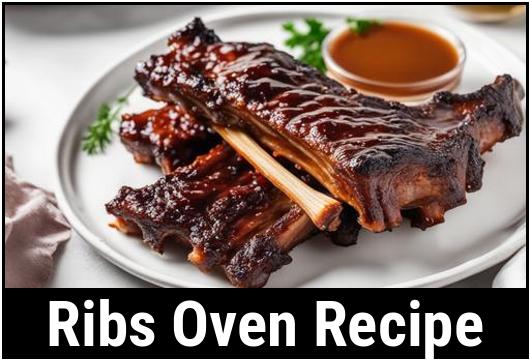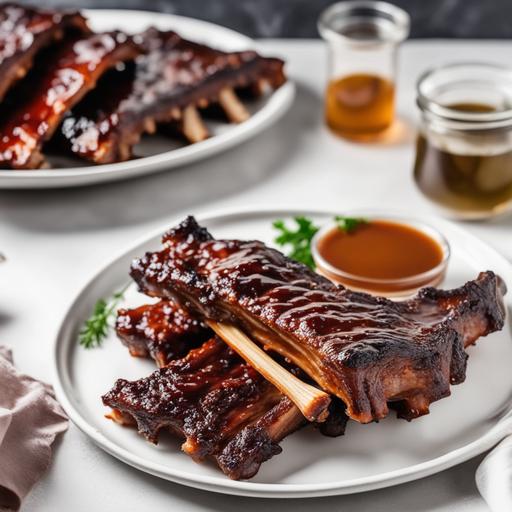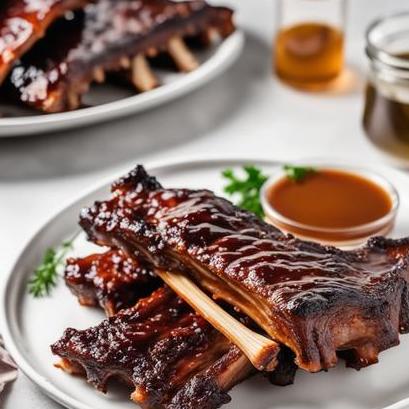- You are here:
- Home »
- Oven Recipes
- » Ribs Oven Recipe – A Comprehensive Guide

Ribs Oven Recipe – A Comprehensive Guide
Ribs are a quintessential dish for any BBQ party or dinner, and cooking them to perfection requires knowledge and skills. However, many people think that ribs are only possible to cook outside, which is untrue. With the right recipe and oven setup, you can easily make delicious and tender ribs indoors. In this article, we will dive deep into the food science and culinary details of ribs, provide you with a step-by-step guide and our tested recipe, and discuss other essential aspects of cooking ribs indoors, such as doneness checks, overcook, undercook, and variations.
The Science behind the Perfect Ribs
To understand how to make the perfect ribs, it is essential to understand the science behind them. Ribs consist of tough yet flavorful meat that requires slow cooking to become tender and juicy. That is why ribs are great for low and slow cooking methods such as oven, smoking, or slow cooker.
To achieve tender ribs, you should pay attention to two major factors – cooking temperature and time. Low heat for a long time is the key to tender ribs. Cooking the ribs under high heat can cause the meat to become dry and tough and may result in overcooked or undercooked ribs.
Moreover, seasoning and marination can enhance the flavors of the ribs and make them more juicy and tender. A good dry rub or marinade can help break down the connective tissues between the meat fibers and make the meat softer and more flavorful.
Types of Ribs
Before we dive into the cooking process, let’s first discuss the different types of ribs. Ribs come from different parts of the pig, and each cut has its unique flavor, texture, and cooking time.
Baby Back Ribs
Baby back ribs are the most popular type of ribs and come from the upper part of the pig’s rib cage. They are smaller in size, leaner, and more tender than other types of ribs. They require less cooking time than other cuts and are perfect for grilling or smoking.
Spare Ribs
Spare ribs come from the lower part of the pig’s rib cage and are larger and meatier than baby back ribs. They have more fat than baby back ribs and are tougher to cook. However, they have a rich flavor and texture and are great for slow cooking methods.
St. Louis Style Ribs
St. Louis style ribs are spare ribs with the rib tips removed. They are meatier and flatter than spare ribs and have a rich flavor and texture. They require more cooking time than baby back ribs but less than spare ribs.
Country Style Ribs
Country-style ribs are cut from the pig’s shoulder and are the least fatty and most meaty among all ribs cuts. They have a chewy texture and require longer cooking time than baby back and St. Louis style ribs.
Selection and Cleaning of Ribs

When selecting ribs from your local store or butcher, look for fresh, meaty, and well-marbled ribs. Avoid selecting ribs that have a yellow or brown tint or those that have a sour smell. These signs indicate that the meat is old or may have gone bad.
Before cooking the ribs, it is essential to clean them properly to remove any dirt and debris. Rinse the ribs under cold water and pat them dry with paper towels.
Preparing Ribs for Cooking
After cleaning, it is time to prepare the ribs for cooking. There are several steps involved in preparing ribs for cooking, such as trimming, seasoning, and marination.
Trimming Ribs
Trimming ribs is an essential step in preparing them for cooking. Trimming involves removing any obtruding fat, the membrane on the bone side, and any other unwanted parts of the ribs. Removing the membrane is important as it can impede the absorption of the seasoning and marinade.
To remove the membrane, use a knife or a finger to loosen one end of it. Then, grab the membrane with a paper towel and pull it off the ribs in one piece. If the membrane breaks, use a knife to loosen it again and try pulling it off.
Seasoning Ribs
Seasoning the ribs is an important step in enhancing the flavor of the meat. You can use a dry rub or a wet marinade to season the ribs.
To make a dry rub, mix together salt, pepper, paprika, garlic powder, onion powder, and brown sugar. Apply the dry rub generously all over the ribs, making sure to rub it into the meat.
For a wet marinade, mix together soy sauce, brown sugar, apple cider vinegar, Worcestershire sauce, and garlic. Pour the marinade over the ribs and let them sit in the refrigerator for at least 2-4 hours or overnight.
Preheating the Oven
Preheating the oven is an important step in cooking ribs. Preheat the oven to 300°F (150°C) and position the rack in the middle of the oven. The low temperature will ensure that the ribs cook slowly and become tender.
Cooking the Ribs
Now that we have prepared the ribs let’s start cooking them. There are two methods for cooking ribs in the oven – foil-wrapped and unwrapped.
Foil-Wrapped Ribs
Foil-wrapped ribs are also known as the "Texas crutch" and are cooked in foil to lock in the moisture and juice. Here’s how to make foil-wrapped ribs:
-
Tear off a sheet of heavy-duty aluminum foil that’s large enough to wrap the ribs.
-
Place the ribs on the foil, bone side down.
-
Close the foil tightly around the ribs, making sure there are no air gaps.
-
Place the wrapped ribs on a baking sheet and put them in the preheated oven.
-
Cook the ribs for 2-2.5 hours. Check the ribs after 2 hours to see if they are tender. If not, continue cooking for another 30 minutes.
Unwrapped Ribs
Unwrapped ribs are cooked in the oven without any covering, which allows the ribs to acquire a smoky and crispy texture. Here’s how to cook unwrapped ribs:
-
Place the seasoned ribs on a baking sheet, bone side down.
-
Put the baking sheet in the preheated oven and cook the ribs for 3-4 hours, depending on the cut and size of the ribs.
-
After 1.5 hours of cooking, baste the ribs with your favorite BBQ sauce.
-
Continue cooking the ribs until they are tender and the internal temperature reaches 195°F (90°C).
Doneness Checks for Ribs

Doneness checks are crucial while cooking ribs to avoid overcooking or undercooking. Here are some ways to check if the ribs are done:
-
Bend Test: Pick up the ribs with tongs at one end and bounce it gently. If the meat starts to crack, it’s done.
-
Temperature Check: Insert an instant-read thermometer between two bones in the thickest part of the ribs. The internal temperature should be 195°F (90°C).
-
Meat Removal: Remove the meat from the bone and check for its tenderness and color. The meat should be juicy, tender, and not dry.
Overcooking and Undercooking Ribs
Overcooking and undercooking ribs can ruin the flavor and texture of the meat. Overcooked ribs can become dry and tough, while undercooked ribs can be chewy and unsafe to eat. Here are some signs that suggest your ribs are undercooked or overcooked:
Overcooked Ribs
-
Dry, tough texture
-
Excessive charring or burning
-
Meat falls off the bone
Undercooked Ribs
-
Chewy, rubbery texture
-
Pinkish color on the meat
-
Blood near the bone
Variations of Ribs
There are many variations of ribs that you can try and experiment with. Below are some popular variations:
-
Smoked Ribs: Smoking adds a smoky and earthy flavour to the ribs, making them even more flavourful.
-
Asian-Style Ribs: Season the ribs with soy sauce, ginger, garlic, and sesame oil for an Asian twist.
-
Spicy Ribs: Add some heat to your ribs by adding cayenne pepper, chili flakes, or hot sauce to your dry rub or marinade.
Recipe for Tender and Juicy Oven Ribs
Here’s our tested recipe for tender and juicy oven ribs:
Ingredients:
-
1-2 racks of ribs
-
2 tbsp of salt
-
2 tbsp of paprika
-
1 tbsp of black pepper
-
1 tbsp of garlic powder
-
1 tbsp of onion powder
-
1 tbsp of brown sugar
-
1 cup of BBQ sauce
Instructions:
-
Preheat the oven to 300°F (150°C).
-
Mix salt, paprika, black pepper, garlic powder, onion powder, and brown sugar in a bowl.
-
Rub the seasoning mix all over the ribs, making sure to cover the meat evenly.
-
Place the seasoned ribs on a baking sheet, bone side down.
-
Put the baking sheet in the preheated oven and cook for 3-4 hours.
-
After 1.5 hours of cooking, baste the ribs with BBQ sauce.
-
Continue cooking the ribs until they are tender and the internal temperature reaches 195°F (90°C).
-
Remove the ribs from the oven and let them rest for 10 minutes.
-
Cut the ribs into individual servings and serve them hot with extra BBQ sauce.
Final Thoughts
Cooking ribs in the oven is an easy and delicious way to enjoy this classic dish indoors. With our comprehensive guide, you now have all the knowledge and skills to make perfectly tender and juicy ribs in your home kitchen. Remember to choose fresh and meaty ribs, prepare them properly, use the right seasoning and marination, cook them low and slow, and check for doneness to avoid overcooking or undercooking. So, next time you crave ribs, fire up your oven, and enjoy this mouth-watering dish!
Sources
FAQS On Ribs Oven Recipe
What Is The Best Cut Of Ribs To Use For An Oven Recipe?
When it comes to oven recipes, pork baby back ribs are the ideal choice. These ribs, taken from the top of the rib section near the backbone, are tender, meaty, and perfect for achieving that fall-off-the-bone texture. They also have a nice balance of fat and muscle, which enhances the flavor and juiciness of the meat.
How Should I Season The Ribs Before Cooking Them In The Oven?
Seasoning the ribs is a crucial step to enhance their flavor. Start by patting them dry with a paper towel, then generously apply a dry rub mixture. This can be a combination of salt, black pepper, paprika, garlic powder, onion powder, and any other desired spices. Rub the mixture all over the ribs, making sure to coat them evenly. For added flavor, let the ribs marinate in the fridge for at least an hour or overnight before cooking.
What Is The Recommended Cooking Temperature And Time For Oven-baked Ribs?
For tender, succulent ribs, it is best to cook them low and slow. Preheat your oven to 275°F (135°C). Place the seasoned ribs on a baking rack set inside a baking sheet to allow air circulation around the ribs. Bake them uncovered for about 2.5 to 3 hours. Cooking times may vary depending on the thickness of the ribs, so it’s essential to check for doneness. You’ll know the ribs are ready when the meat is tender and easily pulls away from the bone.
Should I Cover The Ribs While Baking Them In The Oven?
No, it is recommended to cook the ribs uncovered in the oven. This allows the heat to circulate around the ribs, creating a dry environment that aids in the development of a flavorful crust on the outside while the inside remains tender and juicy. Covering the ribs can trap moisture, resulting in a steamed texture and preventing the desired browning effect.
Can I Use Barbecue Sauce When Cooking Ribs In The Oven?
Yes, adding barbecue sauce during the cooking process can give the ribs a delectable glaze and enhance their taste. After the first 2 hours of cooking, you can brush a generous amount of your favorite barbecue sauce onto the ribs. Return them to the oven for an additional 30 minutes, allowing the sauce to caramelize slightly. Just be careful not to add the sauce too early, as the sugars in the sauce can burn easily during the long cooking time.


